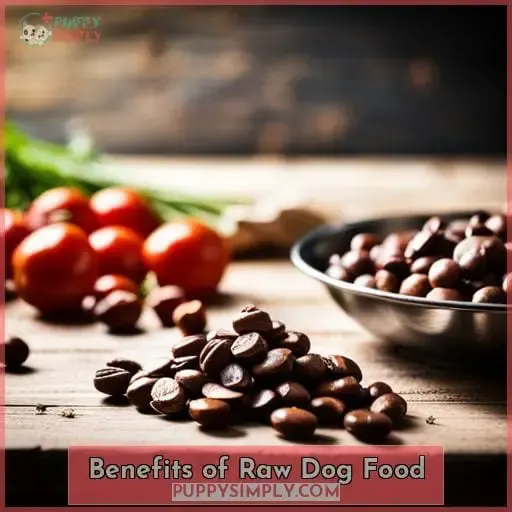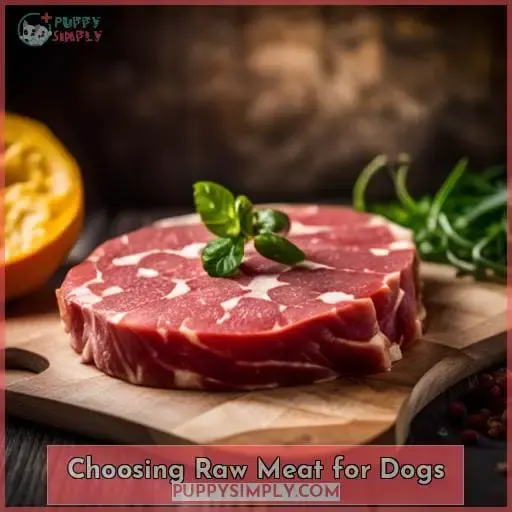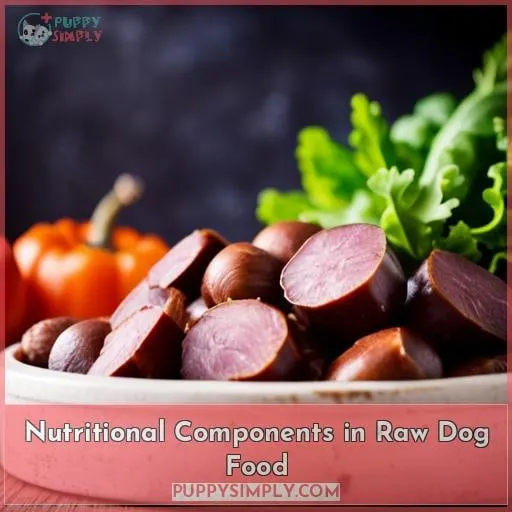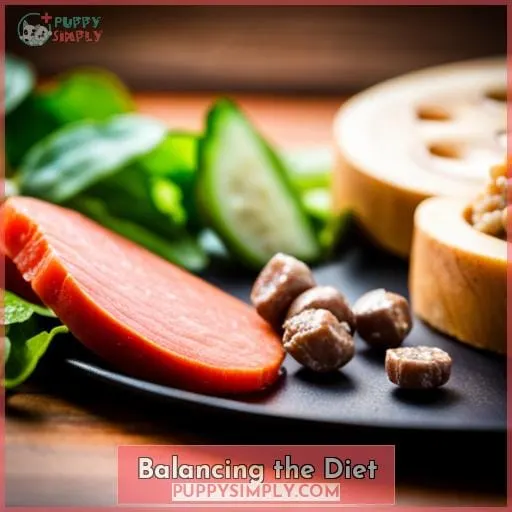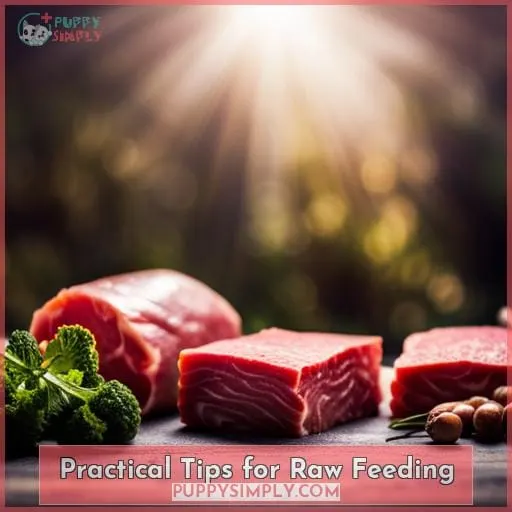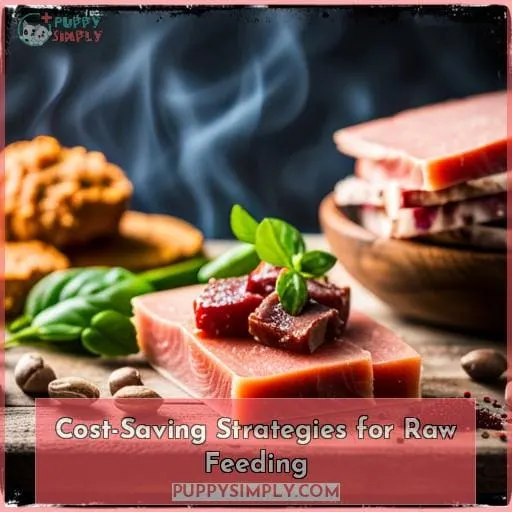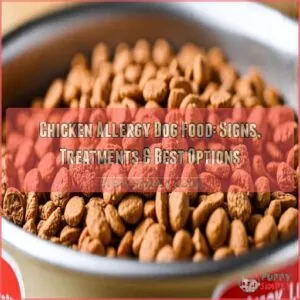This site is supported by our readers. We may earn a commission, at no cost to you, if you purchase through links.
 It’s a commonly held belief that raw dog food can be dangerous or difficult to transition your pup to.
It’s a commonly held belief that raw dog food can be dangerous or difficult to transition your pup to.
In this guide, we’ll dive into everything you need to know about transitioning your best friend onto a nutritionally balanced raw diet. From understanding how much meat they should eat each day (hint: it’s not as much as you think) through to selecting the right ingredients like chicken and beef organ meats for optimal health – by the end of this article, you’ll have all the knowledge needed to start feeding them in line with their genetic makeup just like wolves do in nature.
So let’s get started on creating an ideal raw dog feeding plan tailored specifically for Fido!
Table Of Contents
Key Takeaways
- Benefits of raw dog food include natural, unprocessed ingredients and support for the immune system.
- Raw meat options for dogs include chicken, lamb, pork, duck, rabbit, kangaroo, beef, turkey, and fish.
- Organ meats, such as kidney, liver, spleen, pancreas, and brains, are important for providing essential nutrients in a raw diet for dogs.
- Transitioning to a raw diet can be done gradually or immediately, depending on the dog’s needs and preferences.
Benefits of Raw Dog Food
Raw feeding for dogs is gaining in popularity as more pet owners are recognizing the benefits of providing their canine companions with natural, unprocessed ingredients. The diet of wild canines such as wolves provides a strong foundation for understanding the nutritional needs and requirements that support optimal health, including improved immune system function.
Natural, Unprocessed Ingredients
You can take advantage of the natural nutrients and vitamins found in unprocessed ingredients to ensure your pup is getting a balanced diet. When selecting ingredients, look for a variety of proteins and fats that are suitable for dogs, as well as organ meats like liver, heart, kidney, or brains.
Adding calcium is also important. Bone-in meats provide this mineral as long as it’s not given too frequently or in excess amounts.
The meal preparation should include raw vegetables such as 10% of the total diet to supply polyphenols, which help with immune support and anti-inflammatory properties.
Immune System Support
Switching to a raw diet gives your pup the immune system support they need to feel their best. Natural ingredients and unprocessed meats provide essential macronutrients, vitamins, minerals, and antioxidants needed for optimal health.
Organ meats like liver and heart are packed with nutrients that boost immunity – including taurine for healthy hearts! Polyphenols from vegetables help too, adding anti-inflammatory properties as well as extra vitamins which may be lacking in other diets.
Raw dog food is also rich in omega fatty acids such as EPA/DHA, which play an important role in maintaining a healthy immune system balance.
With all these benefits plus more tasty treats available through ’52 Weeks of Treats’, it’s easy to see why switching your pup over to raw could be life-changing!
Genetic Similarity to Wolves
Your pup’s genetic makeup is similar to their wolf ancestors, so why not consider a diet inspired by them? Wolves’ dietary habits are composed of raw meat and bones as well as other animal parts like organs.
Ancestral dog diets have evolved over the years but still hold many similarities with that of its wild relatives. Raw feeding evolution has opened up a debate between kibble and raw diets due to canine carnivorous genes, which require certain nutrients only found in fresh, whole ingredients.
With careful consideration into transition periods for your pet’s stomach to adjust, you may find yourself on the favor side of this controversial argument when it comes to choosing what type of food best fits your pup’s needs in terms of both nutrition and taste preferences!
Choosing Raw Meat for Dogs
Raw feeding for dogs is an excellent option to give them the nutrition they need, and a variety of raw meats can be used to ensure that your pup gets all the essential nutrients. Meats such as chicken, lamb, pork, duck, rabbit, kangaroo, beef, turkey, and fish are some popular options you may choose from – organ meats like kidney, liver, spleen, pancreas, or brains can also be included in their diet.
Chicken, Lamb, Pork, Duck, Rabbit, Kangaroo, Beef, Turkey, Fish
Explore the variety of proteins that you can include in your dog’s diet, such as chicken, lamb, pork, duck, and rabbit.
When sourcing chicken, ensure it is organic or free-range if possible. Lamb has essential nutrients like zinc, which helps promote healthy skin and coat condition. Pork provides beneficial amino acids to help keep muscles strong, while duck meat contains more fat than other meats but still offers great benefits with its high protein content.
Rabbit is a leaner option that provides plenty of B vitamins, while kangaroo makes an excellent alternative to traditional red meat due to its low fat levels but high nutrient content.
Beef boasts great flavor while also offering vital minerals needed for metabolic processes. However, take note that not all breeds can tolerate higher amounts, so monitor your pet’s health closely when introducing new foods, particularly beef products like liver, kidney, heart, etc.
Lastly, fish, although lower in calories compared to other types of animal proteins, are rich sources of Omega 3 fatty acids, which support cardiovascular function and joint health.
Organ Meats Like Kidney, Liver, Spleen, Pancreas, Brains
Dive into the savory flavor of gourmet organ meats and delight your pup – think kidney, liver, spleen, pancreas, and brains!
Organ meats are an important part of a raw diet for dogs. Kidneys offer essential minerals such as iron and phosphorus. Livers provide fat-soluble vitamins A & D. Spleens help support immune systems.
Pancreases supply insulin to regulate blood sugar levels. Brains contain taurine, which is key for heart health.
For each organ meat, weigh according to body weight (2-5% per day). Rotate proteins regularly and introduce gradually when transitioning from processed food. If these steps aren’t taken, they can lead to nutritional deficiencies or digestive issues in some cases.
Raw dog feeding with organ meats is not only delicious but also nutrient-dense, making them an excellent addition to any pup’s meal plan!
Transitioning to a Raw Diet
Transitioning to a raw diet for your pup can be daunting, but with the right knowledge and approach, it doesn’t have to be. There are two main approaches: a gradual transition or an immediate switch. With careful consideration of your pet’s current health status and lifestyle, you can choose which one is best suited for them.
Gradual Approach
When transitioning to a raw diet, try taking it slow with a gradual approach. This is especially recommended for senior dogs or those who may have allergic reactions. Switching can be challenging and overwhelming, so take your time in introducing the new food slowly over several weeks or months while monitoring your dog’s reaction and progress.
A balanced raw diet should include proteins, fats, calcium from bones, as well as organ meats like liver and heart. These provide essential vitamins B & C plus taurine for healthy hearts. The overall goal when switching is to ensure that the right amount of raw food (2-5% of body weight) is given according to age while avoiding starchy carbs such as grains & legumes, which lead to chronic inflammation.
Give yourself time during this transition period, but remember not all changes happen overnight!
Immediate Switch
If you’re ready to take the plunge and switch your dog immediately to a raw diet, it’s important that you plan ahead. One family successfully transitioned their puppy in two weeks by preparing meals every night for the next day.
When switching immediately, make sure to take safety precautions such as washing hands after handling raw meat and keeping all utensils separate from those used with cooked food. Consider making dietary adjustments based on age and activity level. You can use an online feeding calculator or consult with a veterinary nutritionist if available.
During the transition period, closely monitor your dog’s health for any potential challenges like vomiting or loose stools. These challenges may arise due to the lack of digestive enzymes needed for digesting raw meats, which differ from the processed foods dogs have been accustomed to over years of domestication living off humans’ leftovers.
Nutritional Components in Raw Dog Food
Raw dog food is a great way to provide natural, unprocessed nutrition for your pup. It consists of proteins, fats, and carbohydrates that are essential for muscle building, energy production, and immune system health, respectively.
Protein helps with tissue formation as well as metabolic processes, while fat provides a rich source of energy in addition to hormone production.
Protein, Fat, and Carbohydrates
Discover how protein, fat, and carbohydrates make up the foundation of a raw diet for your pup! Proteins build tissues and enzymes to support metabolic processes. Fats provide an energy source while protecting cells and aiding in hormone production.
Bones should comprise 10%-15% of each meal to ensure adequate calcium intake. Organ meats like liver (10%) and heart (5%) offer unique vitamins & minerals that play important roles in body functions.
Choose bone-in meats smartly and vary protein sources for balanced nutrition. Consult with a raw feeding breeder or research homemade recipes online if needed.
Role of Protein in Building Tissues and Metabolic Processes
Protein plays a major role in building the tissues and metabolic processes of your pup’s body, like an architect constructing a masterpiece. It is essential for muscle development, immune system support, hormone production, and other metabolic functions.
The benefits of protein for dogs are clear. High-quality sources like chicken, lamb, or beef provide crucial amino acids they need to thrive on a raw dog food diet.
Bone-in cuts can be added too. Not only do they add extra flavor, but their calcium content helps build strong bones in pups too!
Finally, omega fats from fish oil help keep the skin healthy while providing energy to power through playtime with you.
Importance of Fat as an Energy Source and for Hormone Production
Fat is an essential part of your pup’s diet, providing them with a rich energy source and aiding in hormone production. Dietary fats help regulate metabolism and are used to transport fat-soluble vitamins throughout the body.
A variety of meat sources provide healthy fats like monounsaturated fatty acids (MUFAs) as well as omega 3 and 6 fatty acids. These polyunsaturated fats promote cell health, control inflammation, support the immune system, and hydrate the skin while giving the coat a healthy shine.
When selecting raw meats for your pup’s diet, look for cuts that contain visible amounts of fat.
Benefits of Carbohydrates in Immune Support
Although carbohydrates aren’t essential for a balanced diet, they can provide your pup with immune-boosting benefits. They offer antioxidants and anti-inflammatory properties that help fight off infections and illnesses.
It’s important to address misconceptions about raw feeding as well. While dogs don’t need starchy carbs like grains or legumes, adding in some vegetables can greatly benefit their health. Homemade treats with raw ingredients, such as bone meal alternatives, are also a great way to ensure your pup gets the most out of their diet.
When handling raw dog food, remember to pay attention to the amount you feed per day (2%-5% of body weight) and vary proteins each week when possible.
Balancing the Diet
When it comes to raw feeding for dogs, it is essential to ensure the right balance of fat and protein, as well as calcium and minerals. Organ meats are also an important part of creating a balanced diet with a mix of saturated and omega fats.
Fat and Protein Balance
It’s important to ensure that your pup’s diet is balanced with the right amount of protein and fat for their individual needs. Protein supports tissue, enzyme, and metabolic processes, while fats provide energy, cell protection, and hormone production.
A raw dog food diet should have a fat content of 10-20% to avoid nutritional issues. Common protein sources include chicken or lamb, but there are other options such as duck or rabbit. Organ meats like liver and heart must also be included as they contain vitamins B & C (liver) and taurine (heart).
The fat content varies among common meals, so it is essential to rotate them regularly. Omega 3 fatty acids help build cell walls for strong immune system support. Feeding guidelines recommend 2-3% of the ideal body weight daily, adjusted according to activity level.
Puppies need more calcium, while active dogs may require extra calories from fats compared to sedentary ones.
Calcium and Mineral Requirements
Satisfy your pup’s mineral needs by ensuring their raw diet contains adequate calcium and other essential minerals. Bone meal helps meet the 10-15% of total calories required, while organ meats provide vitamins B & C plus taurine for heart health.
Sources of Vitamin D include fatty fish. Manganese is found in nuts, seeds, and legumes. Rotating proteins prevents deficiencies. Kangaroo, turkey, or duck are good options to switch up from chicken or beef! Include vegetables too.
Leafy greens offer immune support with anti-inflammatory polyphenols. Monitor fat content (10%-20%) as it can be an issue if excesses occur.
Adding Organ Meats
Including organ meats in your pup’s diet not only provides essential vitamins and minerals, but also offers unique health benefits. Liver is high in B vitamins, Vitamin C, iron, and zinc. Hearts provide an abundance of taurine, which helps with heart health.
When selecting organ meat for your dog’s meal plan, choose grass-fed or organic options to ensure the highest quality nutrients are absorbed into their system.
Additionally, consider adding a variety of organs to prevent nutrient deficiencies. Avoid overfeeding one specific type of organ meat like liver or spleen too often within the same week.
Balancing Saturated and Omega Fats
To ensure your pup is getting a balanced diet, consider adding both saturated and omega fats to their raw meals. Omega fatty acids are important for cell protection, hormone production, and vitamin absorption.
Saturated fat should be kept in check as it can lead to obesity or other health issues if too much is consumed. It’s best to find the right balance between these two types of dietary fat for optimal nutrition.
A good rule of thumb when feeding puppies is that 10-15% of their diet should come from bone content, which provides calcium among other minerals needed for growth and development.
Feeding Guidelines for Dogs
If you’re looking to switch your dog to a raw diet, it’s important to understand the feeding guidelines for adult dogs and puppies.
For adults, feed 2-3% of their ideal body weight per day. Active dogs may need more while sedentary ones need less.
Puppies should get 2-3% of their expected adult weight. Pay attention to calcium and fat levels.
Raw vegetables are also an important part of the diet at 10%. They provide polyphenols, which offer immune support and anti-inflammatory benefits.
Starchy carbohydrates like grains or legumes should be avoided. They can potentially cause chronic inflammation issues in some cases.
Adult Dogs
For adult dogs, you’ll need to adjust their raw food intake based on activity level and provide a balanced diet for optimal health. Feeding frequency should be adjusted according to age – puppies may require more frequent meals than adults.
To ensure nutritional balance, include proteins and fats as the foundation of your dog’s meal plan, along with organ meats for vitamins and minerals. Implement safe practices when handling raw meat – freezing before feeding is recommended.
Dietary variations can offer numerous health benefits. For example, unprocessed ingredients can support the immune system, while taurine found in hearts can protect the heart. Take advantage of natural sources like polyphenols, which offer anti-inflammatory properties without artificial additives or preservatives.
Puppies
When it comes to puppies, it’s essential to ensure they get the right amount of protein and fat for their age, while also accounting for calcium needs.
A raw diet transition should be gradual and begin at 8-12 weeks old. Nutrition should come from meaty bones with 10-15% bone content, along with organs like liver (10%) and heart (5%).
Raw vegetables provide important polyphenols that support immunity. Feeding 2-3% of expected adult weight is recommended, adjusting according to activity level.
Puppies require careful monitoring as too much or too little fat can cause issues.
Raw Vegetables and Polyphenols
Including raw vegetables in your pup’s diet provides essential polyphenols to support their immune system and provide anti-inflammatory benefits. Vegetables such as broccoli, spinach, kale, and cauliflower are packed with antioxidants that help protect cells from damage.
Rich sources of polyphenols can also be found in fruits like apples, pears, blueberries, and cranberries. These key nutrients have been proven to reduce inflammation throughout the body while supporting a healthy gut microbiome for improved digestion.
Adding 10% of raw veggies into your pup’s daily meals will give them all the powerful benefits of natural plant compounds without sacrificing taste or nutrition!
Avoiding Starchy Carbohydrates
Tempting as it may be, steer clear of starchy carbohydrates in your pup’s diet to keep them healthy and strong. Switch up the menu with carbohydrate alternatives like vegetables, fruits, and tubers. These alternatives contain beneficial nutrients for dogs while avoiding dietary inflammation caused by grains and legumes.
Raw diets are also great options if you have a dog with allergies or specific dietary requirements. However, watch out for too much fat content that can lead to nutritional issues.
When done right, raw feeding offers immune support and natural unprocessed ingredients without artificial additives.
Practical Tips for Raw Feeding
Raw feeding for dogs has become increasingly popular in recent years, and with the proper preparation, it can be a healthy addition to any pup’s diet. When transitioning to raw food, it is important to know which foods are safe (freezing raw meat before feeding) and which should be avoided (avoiding toxic foods).
Additionally, there are two main approaches when considering what type of diet: BARF Diet (Biologically Appropriate Raw Food Diet) or Prey Model Diet.
Freezing Raw Meat for Safety
For safety, freeze your raw meat before feeding it to your pup – despite the fact that defrosting takes time.
Keep in mind that when handling raw meats, you should always use proper techniques and follow food safety guidelines for preparation and storage. There are various benefits of freezing raw meat, such as extending shelf life dramatically, eliminating spoilage bacteria growth on the surface of fresh cuts, and controlling odors from fish or gamey meats by marinating them prior to freezing, among others.
When storing frozen foods, opt for airtight containers or bags with minimal air exposure. Avoid overstuffing freezers, which can cause freezer burn due to temperature fluctuations in overloaded units.
Reap these rewards through careful management of handling and storage for safe consumption every time!
Toxic Foods to Avoid
It’s important to steer clear of certain toxic foods when raw feeding, such as onions and garlic. Other dangerous ingredients include grapes, raisins, chocolate, macadamia nuts, and alcohol. Harmful substances like xylitol sweetener should be avoided as well – even in small amounts, it can cause severe reactions in dogs.
Any type of processed food is off-limits too. These contain additives that may be harmful to your pup’s health over time.
Lastly, bones with sharp edges are forbidden dog foods. They can splinter easily, which could cause serious injury or internal damage if ingested by your four-legged friend!
Feeding a safe and nutritious diet is essential to ensure the long-term health of our canine companions.
BARF Diet Vs Prey Model Diet
Comparing the BARF diet and Prey Model diet can help you decide which one is best for your pup. The BARF (Biologically Appropriate Raw Food) Diet offers an evolutionary approach, with components of raw meat, bones, and organs, as well as fresh fruits and vegetables.
Meanwhile, the Prey Model Diet focuses on a single source protein in each meal to mimic what wild dogs would eat in nature.
Both diets offer their own unique benefits such as improved digestion, increased energy levels, and better overall health. However, it’s important to consult your vet before making any dietary changes for your dog.
Dietary Comparison
Evolutionary Diet
Feeding Approaches
Cost-Saving Strategies for Raw Feeding
Raw feeding for dogs is a great way to provide optimal nutrition, but it can come with some costs. Fortunately, there are ways to save money on raw food through bulk buying and portioning, as well as freezing raw meat.
Bulk-buying and Portioning
Making the switch to a raw diet can be expensive, but bulk-buying and portioning make it easier on your wallet.
- Buying in Bulk – order larger quantities of meat for cost savings.
- Portioning Tips – use measuring cups or a kitchen scale to accurately measure out portions.
- Cost Savings – look for sales at local markets or shops related to raw feeding.
- Storage Solutions – store food in airtight containers like mason jars, plastic bags, or Tupperware containers.
- Meal Planning – plan meals ahead of time so you know exactly what ingredients you need and when.
With these tips, you can easily cut down costs without sacrificing nutritional value!
Freezing Raw Meat
To ensure your pup is safe while consuming raw food, freezing the meat can be a cost-efficient strategy. Properly storing and thawing raw meat helps prevent contamination with bacteria such as E.
Freezing also allows you to buy in bulk at discounted prices and portion out meals for future use. When organizing the freezer, consider rotating meats so older packages are used first. Rotate them by using oldest packs on top of newer ones when putting away groceries from shopping trips or moving frozen items around inside the freezer itself.
Finally, keep an eye on expiration dates to avoid expired foods ending up in your pet’s bowl!
Conclusion
Raw feeding for dogs is much like taking a journey, and the destination is a healthier and more fulfilled pup. To ensure a smooth ride, it’s important to understand the basics of raw dog food.
One key aspect is the benefits of natural, unprocessed ingredients. These provide essential nutrients and avoid harmful additives found in commercial dog food.
Another important consideration is the macronutrients and minerals required for a balanced diet. Dogs need a variety of proteins, fats, and carbohydrates, as well as vitamins and minerals, to thrive on a raw food diet.
Rotating protein sources is also crucial. This helps prevent allergies and ensures a well-rounded diet.
When transitioning to a raw dog food diet, it can be done gradually or immediately, depending on the dog’s health and age. Gradual transitions are recommended for dogs with sensitive stomachs or digestive issues.
To make raw dog feeding economically viable, it’s important to be aware of cost-saving strategies. Bulk-buying raw meat, portioning it out, and freezing it can help save money in the long run.
By taking the time to learn the basics of raw dog food and incorporating practical tips, you can ensure your pup’s journey to a healthier and more enriched life.

